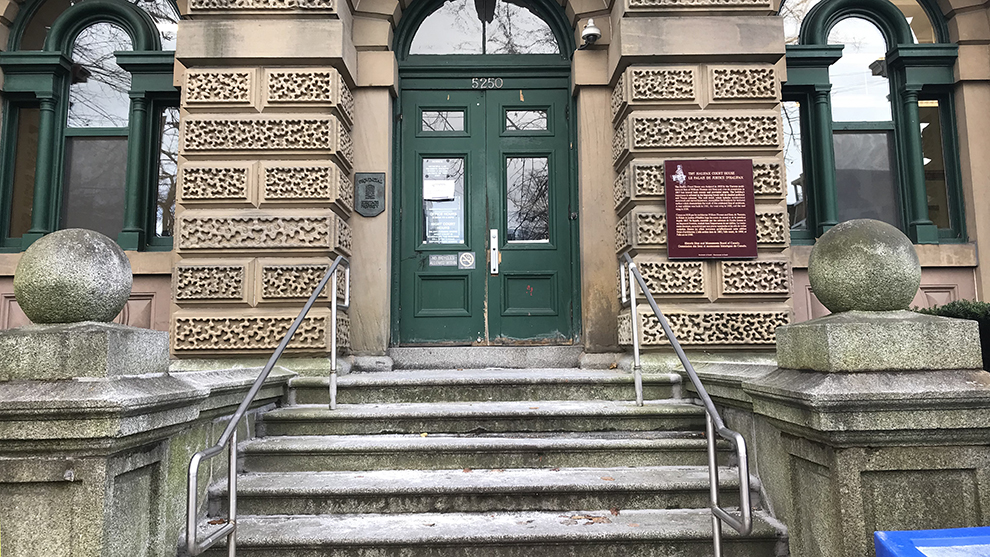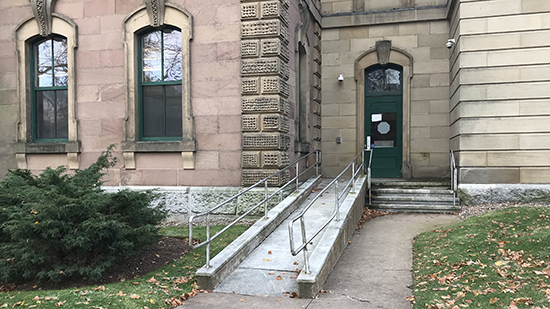Still no proper signage for wheelchair access at Halifax courthouse
Current instructions for wheelchair access cannot be read without climbing stairs

caption
The main entrance to Halifax Provincial court. On the left door, there is a paper sign showing where to go for a ramp entrance. The sign cannot be read without climbing stairs.Editor's Note
This story was updated on Nov. 21 to include a comment from the Department of Justice.
A promise from Nova Scotia’s Department of Justice to improve accessibility signage at Halifax’s provincial court has not been fulfilled beyond a temporary fix.
In August, Skarlet Anne Young told Global News there is a lack of signage at the courthouse on Spring Garden Road. In response, the justice department agreed to solve the issue.
As of Tuesday, two paper signs mark the wheelchair entrance. One at the main doors — at the top of a set of steps — states where to go for wheelchair access.
“That’s so insulting,” Young said in an interview with The Signal. “In order to even read the sign they put up, you have to be able to walk up stairs. That’s pretty awful.” Related stories

caption
The paper sign on the main doors of the courthouse.Young, 43, has Friedreich’s ataxia, a genetic disease that causes impaired speech, loss of sensation in her arms and legs, and trouble walking. She does not use a wheelchair, but it is painful for her to use the stairs.
She expected a sign to be mounted at the base of the stairs, and another at the separate entrance with the ramp. The second piece of paper is on the door of the separate accessible entrance.
“I would have expected more signage than someone printing something off of their computer,” she said.
Young noted that even with proper signage, a sheriff has to let people in and out of the elevator, once inside the building. She says this makes it difficult to enter and leave the building freely.

caption
Skarlet Anne Young stands outside of a Dartmouth coffee shop.Young visited the courthouse in August to support a friend who was in court for a cannabis case. The building is officially accessible, but she didn’t know that because there were no signs telling her the location of the ramp. She had her friends carry her up and down the stairs.
She felt embarrassed.
“It’s a busy spot,” Young said, “and us coming down the big staircase was a spectacle. How can you not notice something like that?”
She said she has been calling the justice department since August, but has not heard back.
As a result of Nova Scotia’s Accessibility Act of 2017, Nova Scotia has promised to become fully accessible by 2030. There is specific mention of improving Nova Scotia’s courts in the Access by Design 2030 plan.
The Signal reached out to the Nova Scotia Department of Justice on Monday. As of Wednesday, they have not responded with comment.
Is it accessible?
Alex LeBlanc also thought the building was inaccessible at first. He was at court the same day as Young to watch the same case.

caption
Alex LeBlanc helps guide accessibility decisions in Nova Scotia as a member of the education standard development committee.LeBlanc was also disappointed to hear there were paper signs on the walls.
“It’s another insult to injury,” he said. “I think it’s a little disrespectful at this point, for our senior government officials to make a statement saying we’re going to receive signage, and within months, nothing has happened.”
He added that there should be a sign visible from the sidewalk to show people where to go if they need an accessible entrance.
“I’m thinking maybe they’re trying to implement procedural steps behind the scenes, but that doesn’t mean temporary signs can’t be done properly,” said LeBlanc.
He said in 2015 he asked a friend to go inside and ask about the accessibility of the building before he attempted to go inside. They ended up using a separate ramp entrance, where he had to ring an unmarked doorbell and wait over 10 minutes for a sheriff to let him inside and escort him up the elevator.

caption
The separate ramp entrance to the courthouse.Both Young and LeBlanc said they had trouble getting back down because only a sheriff can let people in and out of the elevator.
“Once I got up to the third floor I thought, ‘How the heck am I gonna get down?’ said Young.

caption
The buzzer near the accessible door remains unmarked as of Wednesday.LeBlanc is 34 and a father of three. He spent much of his life working in construction and automotive repair before his multiple sclerosis forced him to use a wheelchair in 2013. As an advocate, he is on a provincial committee responsible for improving accessibility in Nova Scotia.
“To me, it’s not acceptable in this day and age, to have criminal trials going on — people advocating for their rights — and not even be able to defend yourself appropriately,” he said. “Because I’m in a wheelchair doesn’t mean I shouldn’t be able to go support my friends at court.”
He says barriers like this make him feel excluded.
“It would be nice if people in wheelchairs were able to participate in society,” he said. “It’s impossible to accommodate every disability all the time, I understand that — but it is 2019.”
Permanent signs
In an email to The Signal on Thursday, a spokesperson for the Department of Justice said the design for permanent signs is done and the new signs will be installed this winter.
“Access to justice is a priority for government, and that includes ensuring our spaces are accessible for all Nova Scotians. The signage at the provincial courthouse on Spring Garden Road is temporary and work is underway to finalize the new signage,” a spokesperson said.
The signs will go at the foot of the stairs, top of the ramp and inside the building “at the proper height.” People will still be required to talk to a sheriff if they need help.
About the author
Julian Abraham
...
